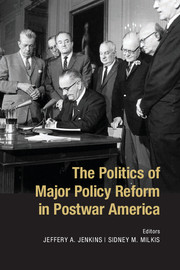Book contents
- Frontmatter
- Contents
- Contributors
- Acknowledgments
- 1 Introduction
- 2 The Long 1950s as a Policy Era
- 3 Regulation, Litigation, and Reform
- 4 Courts and Agencies in the American Civil Rights State
- 5 The Politics of Labor Policy Reform
- 6 Teachers Unions and American Education Reform
- 7 Progressive Federalism and the Contested Implementation of Obama’s Health Reform
- 8 Federalism and the Politics of Immigration Reform
- 9 Trade Politics and Reform
- 10 The Politics of Intelligence Reform
- 11 Follow the Leader
- 12 Conclusion: Madison Upside Down
- Index
- References
8 - Federalism and the Politics of Immigration Reform
Published online by Cambridge University Press: 05 November 2014
- Frontmatter
- Contents
- Contributors
- Acknowledgments
- 1 Introduction
- 2 The Long 1950s as a Policy Era
- 3 Regulation, Litigation, and Reform
- 4 Courts and Agencies in the American Civil Rights State
- 5 The Politics of Labor Policy Reform
- 6 Teachers Unions and American Education Reform
- 7 Progressive Federalism and the Contested Implementation of Obama’s Health Reform
- 8 Federalism and the Politics of Immigration Reform
- 9 Trade Politics and Reform
- 10 The Politics of Intelligence Reform
- 11 Follow the Leader
- 12 Conclusion: Madison Upside Down
- Index
- References
Summary
The National Government has significant power to regulate immigration. With power comes responsibility, and the sound exercise of national power over immigration depends on the Nation’s meeting its responsibility to base its laws on a political will informed by searching, thoughtful, rational civic discourse. Arizona may have understandable frustrations with the problems caused by illegal immigration while that process continues, but the State may not pursue policies that undermine federal law.
– Justice Stevens (Majority)Introduction
What happens when the national government fails to do its job? In Arizona v. United States, the U. S. Supreme Court upheld the federal government’s ability to prevent a state from enacting certain types of immigration laws and regulations perceived by the state as necessary to fill a void in federal enforcement. Nevertheless, the Court allowed the state to continue background checks on people detained for other purposes. Immigration would seemingly work best if different levels of government agreed to coordinate their efforts and share enforcement power. Shared and overlapping powers between the federal government and the individual states lies at the heart of constitutional federalism. It is how our political system was meant to work. Malcolm Feeley and Ed Rubin describe federalism as a means of governance “that grants partial autonomy to geographically defined subdivisions of the polity.” Accordingly, they explain that a “political entity that is governed by a single central government making all significant decisions cannot be described as federal without abandoning the ordinary meaning of the term. Under a federal arrangement, subunits can have considerable authority in certain spheres that overlap with the jurisdictional areas of the central government. Federalism was designed to operate as an important check against the centralized powers of the national government.
- Type
- Chapter
- Information
- The Politics of Major Policy Reform in Postwar America , pp. 179 - 202Publisher: Cambridge University PressPrint publication year: 2014
References
- 1
- Cited by



